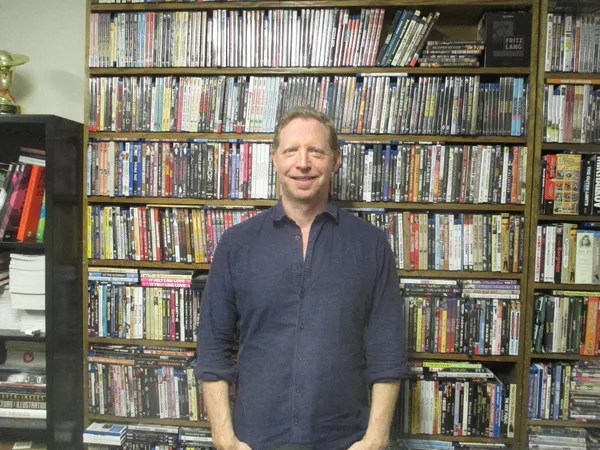 |
| Matt Tyrnauer on Norma Kamali in Studio 54: "She looks extraordinary and she's articulate and so real and was very open and had great insights." Photo: Anne-Katrin Titze |
There is only one filmmaker who has documented Valentino Garavani (Valentino: The Last Emperor), Scotty Bowers (Scotty And The Secret History Of Hollywood), Jane Jacobs (Citizen Jane: Battle For The City) and Ian Schrager (Studio 54). In the second half of my conversation with Matt Tyrnauer, we discuss those films, the work of cinematographer Tom Hurwitz (Griffin Dunne's Joan Didion: The Center Will Not Hold, Bartle Bull's Cradle Of Champions, Neil Barsky's Koch), Michael Jackson, Ron Galella, a Steve Rubell - Roy Cohn connection, and why he choose not to interview Liza Minnelli, Diana Ross and Sylvester Stallone for Studio 54.
By "total coincidence", Matt Tyrnauer had seen The Lifespan Of A Fact, starring Daniel Radcliffe, Cherry Jones and Bobby Cannavale at Studio 54, the evening before we met at Kino Lorber.
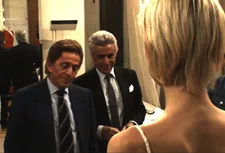 |
| Matt Tyrnauer on Valentino Garavani with Giancarlo Giammetti: "We realize that these two people are speaking about their life together, which they never did publicly before." |
Anne-Katrin Titze: It seems to me that in your films there is always one point where everything shifts suddenly in my head. In paintings, there is sometimes that one kernel that changes how we see the entire picture.
In the Scotty Bowers film it is when he is talking about his childhood near the end. How he sees what everybody else would consider child abuse. His smile at that moment, many things, make it so opaque. I cannot really make sense out of it and I think I'm not supposed to. In Studio 54, I felt it was when Ian Schrager says "My father wouldn't have liked it."
Matt Tyrnauer: I appreciate that observation greatly. I'm enormously pleased that you observed that.
AKT: I was asking myself what it was for Valentino. Something with the pugs?
MT: No, I think for me in that it would be when [Giancarlo] Giammetti refers to Valentino as his lover - as a friend, as a lover. And then Valentino soon after cries when he acknowledges Giammetti and we realise that these two people are speaking about their life together, which they never did publicly before.
AKT: And for Citizen Jane?
MT: It's a very different type of film. In Citizen Jane something happened that I found very moving. The last battle for Manhattan, basically, where they're trying to build the highway through SoHo. It's an archival clip of a demonstration of Italian Americans in Little Italy.
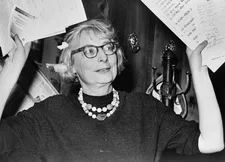 |
| Matt Tyrnauer on Citizen Jane: Battle For The City: "The last battle for Manhattan, basically, where they're trying to build the highway through SoHo." |
Soon after that you see an old Italian woman being interviewed, where she says that they're going to kick her out of her house, that she's an American citizen, but she speaks in a very thick Italian accent. She becomes hysterical and says "What are they going to do? Put me on the street? It is not right."
AKT: I remember that moment in the film.
MT: For me, I love that woman. I thought she was an amazing character. I realized that she is no different than any vulnerable minority of today. We don't think of Italian Americans as a vulnerable minority anymore, but they were in the 1950s and '60s still. But African Americans or anyone of any ethnicity that is challenged, Mexican Americans in the current … who are not legal - they're the vulnerable minority of our season now. That I found to be a shift where you see this is really something that's universal, you know.
AKT: Agreed.
MT: Schrager when he shows that vulnerability - and I think that he had not been forced to ever enunciate that. So you're learning something about him you couldn't possibly know, and that he probably hadn't dealt with in anything approaching a public way before, which is powerful when you see it happen on film.
AKT: Again, you include yourself in the dialogue when he says "I was hoping you wouldn't go there."
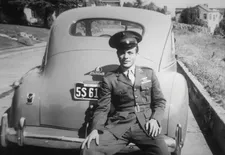 |
| Scotty Bowers in Matt Tyrnauer's Scotty And The Secret History Of Hollywood |
MT: He is someone that doesn't like to be challenged. He doesn't like to be questioned. He is a control freak and he has the success to validate that. By necessity the relationship between the filmmaker and the subject in documentary needs to be uncomfortable at times and challenging. If it's not it's not really a documentary. It's a public relations tool. This is a documentary.
I have final cut on my films. I'm not, you know, an attack dog, but I'm certainly going to ask the questions I want to ask. I thought it was appropriate to show a bit of dialogue between us and dis-ease on his part in the hot seat.
AKT: Norma Kamali is a great interview.
MT: She is fantastic. She looks extraordinary and she's articulate and so real and was very open and had great insights. She and Ian are introverts. They were together as a couple at the time. They were both very shy, introverted non-participants, really, in the circus. They were there at the ringside seat. He was the co-owner of it; she was a big part of his life. They didn't stay. They went home. She never went to the club.
AKT: The way we see images today, there is so much that is cleaned up, filtered out. You wouldn't see the bad skin on Michael Jackson. It is a relief to see the realness. It's nice to show people like this. It's a breath of fresh air.
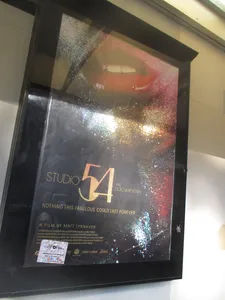 |
| Studio 54 poster at the IFC Center in New York |
MT: I'll get to Jackson in a second because I think that's important. There's a sequence in the film that I'm fond of, it's when we go visit Ron Galella at his archive. He was the inventor of American paparazzi photography. And he can barely walk anymore.
He's a bit arthritic perhaps, walking unsteadily, let's put it that way, through his archive. He grabbed a box and then he shows us his photos. I just think it's a wonderful sequence because you see him now, he's a senior citizen. He's showing you his work which is now years later recognised as art.
But when we showed the film initially to the network - it was an A&E film - one of the comments was "He's a little old, maybe it would be better to minimize him in the film." And I really resisted that. They didn't say "Change that!" I thought that was really the point. It's been 40 years and this is real. We have a fantasy of Studio that is what it is and everyone brings their own kind of fantasy to it.
AKT: Including Whit Stillman. What do you think of Last Days Of Disco?
MT: Actually, I don't remember it.
AKT: I interrupted you.
MT: Not at all, but that kind of rawness and un-pretty-ness was very much the point. Galella is an un-pretty kind of photographer. He made people look okay but it was vérité photography. And then the other point about Michael Jackson is - when I saw that archival footage of him, I resolved not to have celebrity interviews in the film. Because I thought we couldn't do better, really, than having the Michael Jackson in his late teens or early twenties in Studio 54, sitting next to Steve Rubell being interviewed.
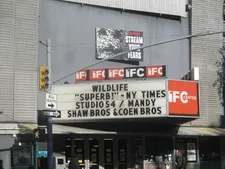 |
| Studio 54 on the IFC Center marquee Photo: Anne-Katrin Titze |
A totally different person than the Michael Jackson we'd remember. Which says so much that I don't even need to comment on it now. What benefit would we get from a Liza Minnelli or a Diana Ross or a Sylvester Stallone, anyone who was there who's world-famous, reflecting on what Studio 54 was? I just thought that it wouldn't be that interesting and that it pulls you out of the movie. Because you sit there in the audience thinking: Did they have a facelift? Is it a good facelift? Is it a bad facelift?
AKT: Tom Hurwitz, your cinematographer, did he have to specially light it? Those questions would have been there. I want to talk about him a little bit, also. But I didn't even notice that you didn't have those celebrity interviews. It didn't even cross my mind until you said it. In other words, I didn't miss them one bit.
MT: Oh good! I'm glad to hear that.
AKT: Your cinematographer did the wonderful Joan Didion documentary and Cradle of Champions as well.
MT: Tom was the cinematographer for my first film on Valentino. I purposely chose a veteran of Cinéma vérité to work with on Valentino because I had never made a film before so I needed someone very strong. And his skills were enormously beneficial. I hadn't worked with him since but this was a New York film, he is a New York photographer, he was around in that era. He has a vérité skill but his way of lighting interviews is very naturalistic, even though it's actually quite complicated.
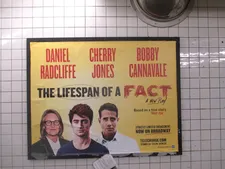 |
| Matt Tyrnauer on seeing The Lifespan Of A Fact starring Daniel Radcliffe, Cherry Jones and Bobby Cannavale at Studio 54: "It was really weird for me to be in there." Photo: Anne-Katrin Titze |
AKT: You never say - oh look, here is the light.
MT: I never want to notice anything's lit and he knows how to do that quite well. He shot the vérité sequences as well and I think they're wonderful. I'm very proud that we made Valentino without one tripod and without one light, actually. I wish I could do all my films like that. Scotty is, I think, the same. I don't think there's any lights or tripods in Scotty. Here we needed a lot of light for the interviews.
AKT: On a personal note, near the end you show some images of Ian Schrager's hotels and there's a shot of The Royalton with that blue carpet. And I suddenly remembered that this is why in my first apartment, I had a blue carpet just like it. I had a little flight of stairs and I wanted precisely this Royalton blue carpet.
MT: It was amazing. It's such a tragedy that interior was taken out. It was one of the greatest. It should have been landmarked.
AKT: Yes. Do you feel with Studio 54 that you have "been there" after making the film?
MT: Yeah, I do in a way. I never was there. I actually bizarrely was at a play [The Lifespan Of A Fact] at the theatre last night. It was a total coincidence. Someone took me to the theatre. It's with Daniel Radcliffe and Cherry Jones and Bobby Cannavale. So I was in the space [former Studio 54] last night. It was really weird for me to be in there.
AKT: What's coming up next for you?
MT: I'm cutting a movie about [Don’t Mess with] Roy Cohn and it's basically Roy Cohn's America. The idea came out of my Studio 54 work because Roy Cohn was the lawyer for Schrager and Rubell and he is very much in the archival. I found him kind of dark and mesmerizing as a character.
AKT: Looking forward to it. Thank you.
MT: Thank you for your most intelligent questions.
Studio 54 is in cinemas in the US.





















